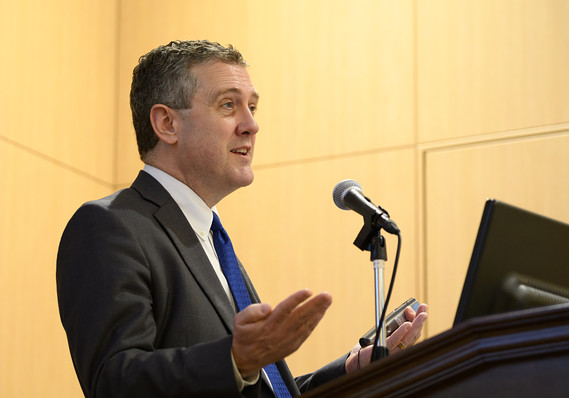 Bloomberg News/Landov
Bloomberg News/Landov
At its last policy meeting in early May, the Federal Reserve said it was going to be patient for some time before changing interest rates.
“Some time” may turn out to be all of two months.
Economists expect the Fed to try to back away gracefully from that stance with a new pledge to cut interest rates, if warranted.
Over the last few weeks, escalating trade tensions and a sense that the economy is on a slowing trend have led the market to price in over two cuts this year, according to futures trading as shown by the CME Group’s Fed Watch tool.The market is pricing in an 80% chance of a quarter-point reduction in July.
So a Fed remaining on hold, if poised to act, presents a communications challenge to Fed Chairman Jerome Powell.
“It’s not a soft shoe that I envy,” said Guy LeBas, chief fixed income strategist at Janney Capital Management.
Here is what to watch when the Fed announces its decision at 2 p.m. Eastern on Wednesday.
The Fed’s dot plot, adopted in 2011, has never been used during an easing cycle.
1. Patient but ready. In its last policy statement in early May, the FOMC said: “in light of global economic and financial developments and muted inflation pressures, the Committee will be patient as it determines what future adjustments to the target range for the federal funds rate may be appropriate to support these outcomes.”
Economists are expecting the central bank to hold the benchmark federal-funds target rate in a range between 2.25% and 2.5% while rewriting the language to signal some greater degree of readiness to adjust policy.
“It may do this by adding language on sensitivity to data and developments to its conception of patience,” said Daniel Ahn, chief U.S. economist at BNP Paribas.
Some economists think the statement might also might highlight the “downside risks” posed by global and financial developments.
2. Dots in a new world. The Fed’s dot plot, adopted in 2011, has never been used during an easing cycle and economists aren’t sure if the Fed wants to point to future easing. Many think that Fed officials will mark down estimates to reflect anticipated cuts but the median 2019 dot is expected to still show no change in policy. On the other hand, economists expect the median 2020 dot to move down and imply no more hikes in the rate path. In March, the 2020 dot plot penciled in one hike.
3. “Act as appropriate.” The stock market DJIA, -0.07% SPX, -0.16% soared in early June after Powell, speaking at a conference at the Chicago Fed, said he and his colleagues “are closely monitoring the implications of these [trade] developments for the U.S. economic outlook and, as always, we will act as appropriate to sustain the expansion.” Some tool that as a clear sign the Fed was willing to consider cutting interest rates to keep the expansion intact. But others saw it as a bland reiteration of the Fed’s philosophy. All eyes will be on Powell when he’s asked about Fed communication during the press conference.
4. Dissent. St. Louis Fed President James Bullard said recently that a rate cut may be warranted “soon” to help provide some insurance in case of a steeper-than-expected slowdown and the stop inflation expectations from dropping. Because Bullard is a voting member of the FOMC this year., economists will be watching to see if he will formally dissent if his colleagues decide to hold policy steady.
5. The Fed’s desired market reaction: Matthew Luzzetti, chief U.S. economist at Deutsche Bank, said the Fed’s goal in its communication is to “send a sufficiently dovish message” that would keep financial conditions easy and extend the decision about whether to cut to July. “If the Committee is unable to navigate this balancing act, and the market deems the message as insufficiently dovish, financial conditions could tighten enough to trigger a more aggressive Fed response in July,” he said.
LeBas of Janney isn’t optimistic. The Powell Fed has had 10 meetings to date and the equity market has ended lower after nine of them finished, he noted.




